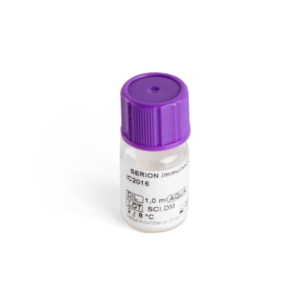| Weight | 1 lbs |
|---|---|
| Dimensions | 9 × 5 × 2 in |
| target | Enterovirus |
| species reactivity | Enterovirus |
| applications | ELISA |
| assay type | Indirect & quantitative |
| available size | 1 mg |
Enterovirus Antigen BA133VS01
$1,054.00
Summary
- Virion/Serion Immunologics Antigen for research use (RUO)
- Enterovirus Antigen, recombinant
- Suitable for detection of IgA, IgG & IgM antibodies in ELISA
- Lot specific concentration, specified in mg/mL
- 1 mg
Enterovirus Antigen BA133VS01
| kit |
|---|
| Research area Infectious Disease |
| Storage Store at -65°C or lower. Avoid repeated freeze-thaw cycles. 10 years from date of manufacture (under recommended storage conditions). |
| Form liquid |
| Associated products Enterovirus Antigen (BA133VS01) Enterovirus IgA Control Serum (BC133A) Enterovirus IgG Control Serum (BC133G) Enterovirus IgM Control Serum (BC133M) Enterovirus IgA ELISA Kit (ESR133A) Enterovirus IgG ELISA Kit (ESR133G) Enterovirus IgM ELISA Kit (ESR133M) |
| target relevance |
|---|
| Organism Enterovirus |
| Protein names Enterovirus |
| Structure and strains Enterovirus is a genus of positive-sense single-stranded RNA viruses associated with several human and mammalian diseases. Enteroviruses are named by their transmission-route through the intestine ('enteric' meaning intestinal). Serologic studies have distinguished 71 human enterovirus serotypes on the basis of antibody neutralization tests. Additional antigenic variants have been defined within several of the serotypes on the basis of reduced or nonreciprocal cross-neutralization between variant strains. On the basis of their pathogenesis in humans and animals, the enteroviruses were originally classified into four groups, polioviruses, Coxsackie A viruses (CA), Coxsackie B viruses (CB), and echoviruses, but it was quickly realized that there were significant overlaps in the biological properties of viruses in the different groups. Enteroviruses isolated more recently are named with a system of consecutive numbers: EV-D68, EV-B69, EV-D70, EV-A71, etc., where genotyping is based on the VP1 capsid region. Enteroviruses affect millions of people worldwide each year and are often found in the respiratory secretions (e.g., saliva, sputum, or nasal mucus) and stool of an infected person. Historically, poliomyelitis was the most significant disease caused by an enterovirus, namely poliovirus. There are 81 non-polio and 3 polio enteroviruses that can cause disease in humans. Of the 81 non-polio types, there are 22 Coxsackie A viruses, 6 Coxsackie B viruses, 28 echoviruses, and 25 other enteroviruses. |
| Detection and diagnosis The demonstration of infection by the detection of specific antibodies generally requires the analysis of serum pairs. A positive result for IgM or IgA combined with rising IgG activity serves as clear evidence of an acute or recent infection. Persisting IgM and IgA antibody levels are frequently observed in chronic infections. |
Data
Publications
| pmid | title | authors | citation |
|---|---|---|---|
| We haven't added any publications to our database yet. | |||
Protocols
| relevant to this product |
|---|
| BA133VS01 protocol |
Documents
| Product data sheet |
|---|
| BA133VS01 |
Only logged in customers who have purchased this product may leave a review.














Reviews
There are no reviews yet.